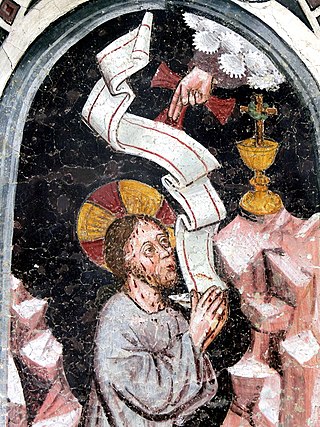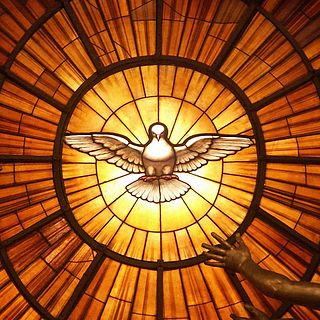
Speaking in tongues, also known as glossolalia, is an activity or practice in which people utter words or speech-like sounds, often thought by believers to be languages unknown to the speaker. One definition used by linguists is the fluid vocalizing of speech-like syllables that lack any readily comprehendible meaning. In some cases, as part of religious practice, some believe it to be a divine language unknown to the speaker. Glossolalia is practiced in Pentecostal and charismatic Christianity, as well as in other religions.
Pentecostalism or classical Pentecostalism is a Protestant Charismatic Christian movement that emphasizes direct personal experience of God through baptism with the Holy Spirit. The term Pentecostal is derived from Pentecost, an event that commemorates the descent of the Holy Spirit upon the Apostles and other followers of Jesus Christ while they were in Jerusalem celebrating the Feast of Weeks, as described in the Acts of the Apostles.

A spiritual gift or charism is an extraordinary power given by the Holy Spirit. These are believed by followers to be supernatural graces that individual Christians need to fulfill the mission of the Church. In the narrowest sense, it is a theological term for the extraordinary graces given to individual Christians for the good of others and is distinguished from the graces given for personal sanctification, such as the Seven Gifts of the Holy Spirit and the fruit of the Holy Spirit.
The Azusa Street Revival was a historic series of revival meetings that took place in Los Angeles, California. It was led by William J. Seymour, an African-American preacher. The revival began on April 9, 1906, and continued until roughly 1915.

The International Pentecostal Holiness Church (IPHC) or simply Pentecostal Holiness Church (PHC) is an international Holiness-Pentecostal Christian denomination founded in 1911 with the merger of two older denominations. Historically centered in the Southeastern United States, particularly the Carolinas and Georgia, the Pentecostal Holiness Church now has an international presence. In 2000, the church reported a worldwide membership of over one million—over three million including affiliates.
The charismatic movement in Christianity is a movement within established or mainstream Christian denominations to adopt beliefs and practices of Charismatic Christianity, with an emphasis on baptism with the Holy Spirit, and the use of spiritual gifts (charismata). It has affected most denominations in the United States, and has spread widely across the world.
In Christian theology, baptism with the Holy Spirit, also called baptism in the Holy Spirit or baptism in the Holy Ghost, has been interpreted by different Christian denominations and traditions in a variety of ways due to differences in the doctrines of salvation and ecclesiology. It is frequently associated with incorporation into the Christian Church, the bestowal of spiritual gifts, and empowerment for Christian ministry. Spirit baptism has been variously defined as part of the sacraments of initiation into the church, as being synonymous with regeneration, or as being synonymous with Christian perfection. The term baptism with the Holy Spirit originates in the New Testament, and all Christian traditions accept it as a theological concept.

The Toronto Blessing, a term coined by British newspapers, refers to the Christian revival and associated phenomena that began in January 1994 at the Toronto Airport Vineyard church (TAV), which was renamed in 1996 to Toronto Airport Christian Fellowship (TACF) and then later in 2010 renamed to Catch the Fire Toronto. It is categorized as a neo-charismatic Evangelical Christian church and is located in Toronto, Ontario, Canada. The revival impacted charismatic Christian culture through an increase in popularity and international reach and intensified criticism and denominational disputes. Criticism primarily centered around disagreements about charismatic doctrine, the Latter Rain Movement, and whether or not the physical manifestations people experienced were in line with biblical doctrine or were actually heretical practices.
Signs and wonders refers to experiences that are perceived to be miraculous as being normative in the modern Christian experience, and is a phrase associated with groups that are a part of modern charismatic movements and Pentecostalism. This phrase is seen multiple times throughout the Bible to describe the activities of the early church, and is historically recorded as continuing, at least in practice, since the time of Christ. The phrase is primarily derived from Old and New Testament references and is now used in the Christian and mainstream press and in scholarly religious discourse to communicate a strong emphasis on recognizing perceived manifestations of the Holy Spirit in the contemporary lives of Christian believers. It also communicates a focus on the expectation that divine action would be experienced in the individual and corporate life of the modern Christian church, and a further insistence that followers actively seek the "gifts of the Spirit".

The Catholic Charismatic Renewal (CCR) is a movement within the Catholic Church that is part of the wider charismatic movement across historic Christian churches.
The Neo-charismaticmovement is a movement within evangelical Protestant Christianity that is composed of a diverse range of independent churches and organizations that emphasize the current availability of gifts of the Holy Spirit, such as speaking in tongues and faith healing. The Neo-charismatic movement is considered to be the "third wave" of the Charismatic Christian tradition which began with Pentecostalism, and was furthered by the Charismatic movement. As a result of the growth of postdenominational and independent charismatic groups, Neo-charismatics are now believed to be more numerous than the first and second wave categories. As of 2002, some 19,000 denominations or groups, with approximately 295 million individual adherents, were identified as Neo-charismatic.
In Christian theology, the Gift of Miracles is among the spiritual gifts (charismata) mentioned by St. Paul in his First Epistle to the Corinthians. As a charism, the gift is imparted to certain individuals through the power of the Holy Spirit.

The Assemblies of God USA (AG), officially The General Council of the Assemblies of God, is a Pentecostal Christian denomination in the United States and the U.S. branch of the World Assemblies of God Fellowship, the world's largest Pentecostal body. The AG reported 2.9 million adherents in 2022. In 2011, it was the ninth largest Christian denomination and the second largest Pentecostal denomination in the United States. The Assemblies of God is a Finished Work denomination, and it holds to a conservative, evangelical and classical Arminian theology as expressed in the Statement of Fundamental Truths and position papers, which emphasize such core Pentecostal doctrines as the baptism in the Holy Spirit, speaking in tongues, divine healing and the Second Coming of Jesus Christ.

Richard B. Gaffin, Jr. is a Calvinist theologian, Presbyterian minister, and was the Charles Krahe Professor of Biblical and Systematic Theology at Westminster Theological Seminary in Philadelphia, Pennsylvania from 1999 to 2008. He became the Professor Emeritus, Biblical and Systematic Theology in 2008.
Spiritual drunkenness refers to a phenomenon seen in some Christian denominations, particularly those associated with Pentecostalism and the Charismatic Movement, in which individuals who are said to be experiencing intense momentary visitations of—or even possession by—the Holy Spirit exhibit a range of behaviors resembling signs of moderate to severe alcoholic inebriation, including unsteadiness, uncontrollable laughter, silly expressions or gestures, verbal or nonverbal shouting, sudden intense fatigue, and temporary unconsciousness. The phenomenon typically occurs during Pentecostal and charismatic church services, usually at the prompting of a preacher or pastor, and most often involving multiple members of a congregation at a time, generally after having been "transferred" from one person to another via respiratory blowing or laying on of hands. It also can occur at more intimate settings including housegroups and fellowship meetings of believers, wherever the Holy Spirit is free to move and have His way. The experiences are meant to bring people into a deeper encounter of God's love, power, presence and joy. The result should be a positive one, leading one to a more holy and joyous life.
The Samoan Assemblies of God International or SAOG is a Pentecostal fellowship of churches. It reached the Western Islands and outer countries with large Samoan communities, such as New Zealand, America and Australia. It has over 530 churches worldwide with over 97,000 adherents.

Cessationism versus continuationism involves a Christian theological dispute as to whether spiritual gifts remain available to the church, or whether their operation ceased with the Apostolic Age of the church. The cessationist doctrine arose in the Reformed theology: initially in response to claims of Roman Catholic miracles. Modern discussions focus more on the use of spiritual gifts in the Pentecostal and Charismatic movements, though this emphasis has been taught in traditions that arose earlier, such as Methodism.
Holy laughter is a term used within charismatic Christianity that describes a religious behaviour in which individuals spontaneously laugh during church meetings. It has occurred in many revivals throughout church history, but it became normative in the early 1990s in Neo-charismatic churches and the Third Wave of the Holy Spirit. Many people claimed to experience this phenomenon at a large revival in Toronto, Ontario, Canada known as the Toronto Blessing.

The Sword of the Spirit is an international, ecumenical association of Christian communities within the charismatic movement. As of 2017, the Sword of the Spirit is composed of 82 communities, 45 of which are Catholic. The member communities are composed predominantly of laypersons. The Sword of the Spirit is one of the largest federated networks of communities to come out of the Catholic charismatic renewal.
Charismatic Christianity is a form of Christianity that emphasizes the work of the Holy Spirit and spiritual gifts as an everyday part of a believer's life. It has a global presence in the Christian community. Practitioners are often called Charismatic Christians or Renewalists. Although there is considerable overlap, Charismatic Christianity is often categorized into three separate groups: Pentecostalism, the Charismatic movement, and the Neo-charismatic movement.








